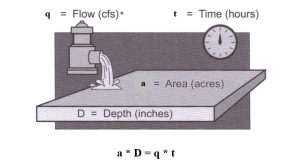Chapter 101.3 – Using the Irrigator’s Equation to Quantify Irrigation Variables
Irrigator’s Equation

A lot of equations can be looked up whenever you need to use them, but this irrigator's equation is one you will use a lot. We suggest you become very familiar with it. We will give you some practice in using it later in this section.
In the following 8 minutes video, Dr. Andales will introduce you to the Irrigator’s Equation.
To summarize the video clip, the Irrigator’s Equation is given by:
Click on each “i” symbol to reveal the definition of each part of the equation.
The relationships among the four variables in equation [1] are shown visually in Fig. 1-4. The Irrigator’s equation shows that the volume of water applied (i.e., a * D) on a given area is equal to the volume of water that flows through the irrigation system (i.e., q * t). Both sides of the equation give quantities of water volume.

If you know the values of at least three variables in the Irrigator’s equation, then you can solve for the value of the unknown variable.
Solve Different Real-World Challenges
Work through three different scenarios below to see how you can use the Irrigator's Equation to solve different real world challenges.
Review
Using the Irrigator’s Equation, answer the following questions.

Earn an industry recognized micro-credential at: CSU Upskill.
Irrigator's Equation is (a * D = q * t); where a = irrigated area, D = depth of applied water, q = volume flow rate of irrigated system, and t = run time.
